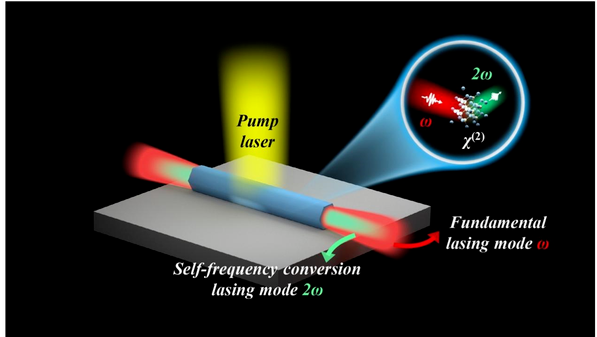Reviewed by Alex SmithMay 9 2022
Nanowire (NW) lasers with the NW concurrently serving as optical cavity and gain medium are appealing for miniaturized photonic integration platforms, which have the advantages of an ultracompact footprint, low energy consumption, easy integration and potential large-scale production.
 Schematic diagram of the self-frequency-conversion nanowire laser. Image Credit: Ruixuan Yi, Xutao Zhang, Chen Li, Bijun Zhao, Jing Wang, Zhiwen Li, Xuetao Gan, Li Li, Ziyuan Li, Fanlu Zhang, Liang Fang, Naiyin Wang, Pingping Chen, Wei Lu, Lan Fu, Jianlin Zhao, Hark Hoe Tan, and Chennupati Jagadish.
Schematic diagram of the self-frequency-conversion nanowire laser. Image Credit: Ruixuan Yi, Xutao Zhang, Chen Li, Bijun Zhao, Jing Wang, Zhiwen Li, Xuetao Gan, Li Li, Ziyuan Li, Fanlu Zhang, Liang Fang, Naiyin Wang, Pingping Chen, Wei Lu, Lan Fu, Jianlin Zhao, Hark Hoe Tan, and Chennupati Jagadish.
After 20 years of development, NW lasers have been established in a range of materials, like perovskites, and III-V and II-VI compound semiconductors. Moreover, the addition of quantum dots and quantum wells in NWs can further decrease the lasing threshold and enhance the temperature constancy of NW lasers.
In the last few years, the creation of selective area epitaxy facilitates NW array lasers possessing high output power. These accomplishments significantly boost the applications of NW lasers, including sensing, displaying, optical interconnects, and microscopy.
Regrettably, restricted by the specific gain spectral range innate in semiconductors, there are still a few difficult wavelengths that cannot be realized using NW lasers, thus narrowing their usage.
Even if the emission peaks of semiconductor NW could be ideally shifted over a wide range by regulating the alloy composition, there are still several material-related difficulties to the NW growth. For instance, green InGaN NW lasers are still not achieved because of the high density of dislocations in the high-indium content quantum well.
In the history of the progress of lasers used in industry and laboratories, the laser functional wavelength range is also restricted by the gain medium. But at present, the commercial lasers could offer lucid output ranging from ultraviolet (UV) to THz.
One of the most critical pieces of equipment is to use an external nonlinear optical crystal to realize nonlinear optical parametric conversions, including difference-frequency generation (DFG), second-harmonic generation (SHG), optical parametric amplifier (OPA), sum-frequency generation (SFG), optical parametric oscillation (OPO), etc.
For instance, the high-power green laser at 532 nm is usually achieved by frequency-doubling the Nd:YAG laser at 1,064 nm via the SHG. Furthermore, based on OPA or OPO, lasers could be nonstop tuned over 1,000 nm in the near-infrared range. These accomplishments stimulate the use of nonlinear frequency conversion to spread the output wavelength range of NW lasers.
A research team, guided by Professor Xuetao Gan and Professor Jianlin Zhao from Key Laboratory of Light Field Manipulation and Information Acquisition, Ministry of Industry and Information Technology, and Shaanxi Key Laboratory of Optical Information Technology, School of Physical Science and Technology, Northwestern Polytechnical University, China and their collaborators have suggested that the operational wavelength of NW laser could be extended by exploiting the second-order nonlinear effect of NW crystal.
The new study has been published in the journal Light Science & Application.
However, in contrast to conventional solutions using an external non-linear crystal, the suggested solution makes the most of the high non-linearities of III-V NW itself and the robustly localized optical field inside the laser cavity to realize frequency conversion.
Furthermore, the second-order nonlinear optical procedures could be self-realized successfully. It is, however, unfeasible to utilize NW lasers as the source to pump another nonlinear crystal to accomplish frequency conversion because of the low output energy of NW lasers.
In the study experiment, high-quality GaAs/In0.16Ga0.84As core/shell NWs were grown using the selective area epitaxy (SAE) technique and shifted to a SiO2/Si substrate. The two flat end facets work as two parallel mirrors and develop a Fabry–Pérot cavity as the optical cavity for the laser. From a NW with a single lasing mode at 1,016 nm, a robust visible lasing peak at 508 nm is also achieved.
By examining the far-field polarization reliance with numerical modeling and the intensity reliance, it is established that the visible laser mode at 508 nm is produced by doubling the frequency of the fundamental lasing mode (SHG), i.e., the self-frequency-conversion method.
In addition to SHG, the second-order nonlinear effect of III-V NW also aids other three-wave mixing processes, like DFG, SFG, etc., which could also be exploited to lengthen the output wavelength of NW lasers. In the study experiment, multimode lasing in near-infrared is validated in a NW with a bigger diameter, and numerous lasing peaks are attained in the visible wavelength range.
Based on the calculation of the frequency conversion and equivalent experiment, the lasing modes at these wavelengths could be instantly correlated to the SFG and SHG signals of the major lasing modes.
The three-wave-mixing procedures of these major lasing modes also comprise their DFGs, which could produce signals at the mid-infrared wavelength range. For instance, the corresponding DFG of λ2 and λ4 (ω2-ω4) is anticipated at the wavelength of 6,678 nm.
However, restricted by the spectrum range of test instruments, the scientists did not detect the DFG signal. With further reduction of the frequency variance of two major lasing modes, the frequency of DFG could also be redshifted to THz.
In conclusion, the researchers believed that by manipulating the second nonlinear effect of the NWs, the suggested self-frequency-conversion NW lasers offer a new route for increasing the working wavelength of these lasers, with potential applications in amplifiers, optical parametric generators and oscillators working over a large wavelength range from deep UV to THz.
Journal Reference:
Yi, R., et al. (2022) Self-frequency-conversion nanowire lasers. Light: Science & Applications volume. doi.org/10.1038/s41377-022-00807-7.